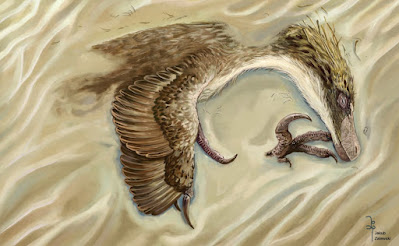 |
| Shri devi Turner, Montanari & Norell, 2021 Artwork by Jakub Zalewski |
Numerous dromaeosaurid taxa recovered from the Upper Cretaceous strata of the Gobi Desert raise questions over niche partitioning among closely related species. Here, I describe a dromaeosaurid specimen from the Baruungoyot strata of the Khulsan locality, containing a partial skull in close association with the left hind limb. The material can be referred to the velociraptorine Shri devi, until now known only from a single specimen lacking a skull, collected from the same site. The referral is based on the apomorphic morphology of the pes, including the highly hypertrophic ungual of the second digit and details of the metatarsus. The skull of S. devi confirms its close affinities with Velociraptor mongoliensis, but shows distinctive features among Velociraptorinae, including a short antorbital fenestra, a Z-shaped maxillo-jugular suture, a distinct labial ridge above the supralabial foramina row of the maxilla, and the posterior position of the last maxillary tooth. The skull of S. devi is slender, but relatively short when compared to other velociraptorines, suggesting convergence to the North American eudromaeosaurians. The Baruungoyot strata with S. devi represent less arid conditions than the aeolian Djadokhta strata yielding V. mongoliensis, supporting earlier observations linking the elongation of the dromaeosaurid snout with the environment.
Key words: Dinosauria, Theropoda, Dromaeosauridae, convergence, Cretaceous, Mongolia, Gobi Desert.
Łukasz Czepiński. 2023. Skull of A dromaeosaurid Dinosaur Shri devi from the Upper Cretaceous of the Gobi Desert suggests Convergence to the North American forms. Acta Palaeontologica Polonica. in press. DOI: 10.4202/app.01065.2023






